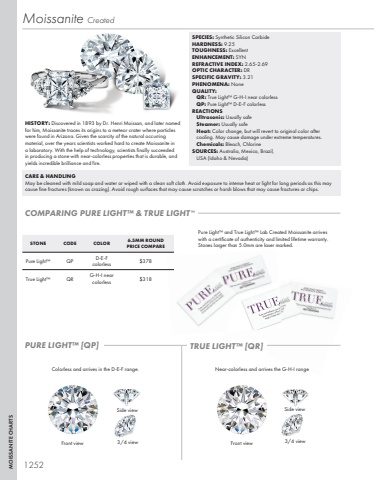Page 1262 - Demo
P. 1262
MOISSANITE CHARTS1252Front viewSide view3/4 viewColorless and arrives in the D-E-F range. Front viewSide view3/4 viewNear-colorless and arrives the G-H-I rangeHISTORY: Discovered in 1893 by Dr. Henri Moissan, and later named for him, Moissanite traces its origins to a meteor crater where particles were found in Arizona. Given the scarcity of the natural occurring material, over the years scientists worked hard to create Moissanite in a laboratory. With the help of technology, scientists finally succeeded in producing a stone with near-colorless properties that is durable, and yields incredible brilliance and fire.COMPARING PURE LIGHT%u2122 & TRUE LIGHT %u2122STONE CODE COLOR 6.5MM ROUND PRICE COMPAREPure Light%u2122 QP D-E-F colorless $378True Light%u2122 QR G-H-I near colorless $318PURE LIGHT%u2122 [QP] TRUE LIGHT%u2122 [QR]Pure Light%u2122 and True Light%u2122 Lab Created Moissanite arrives with a certificate of authenticity and limited lifetime warranty. Stones larger than 5.0mm are laser marked.Moissanite CreatedSPECIES: Synthetic Silicon CarbideHARDNESS: 9.25TOUGHNESS: ExcellentENHANCEMENT: SYNREFRACTIVE INDEX: 2.65-2.69OPTIC CHARACTER: DRSPECIFIC GRAVITY: 3.21PHENOMENA: NoneQUALITY:QR: True Light%u2122 G-H-I near colorlessQP: Pure Light%u2122 D-E-F colorlessREACTIONSUltrasonic: Usually safeSteamer: Usually safeHeat: Color change, but will revert to original color after cooling. May cause damage under extreme temperatures.Chemicals: Bleach, ChlorineSOURCES: Australia, Mexico, Brazil, USA (Idaho & Nevada)CARE & HANDLINGMay be cleaned with mild soap and water or wiped with a clean soft cloth. Avoid exposure to intense heat or light for long periods as this may cause fine fractures (known as crazing). Avoid rough surfaces that may cause scratches or harsh blows that may cause fractures or chips.


